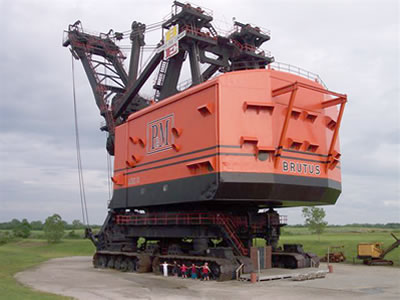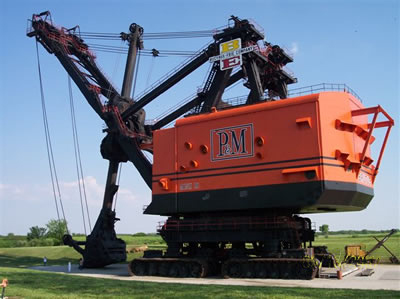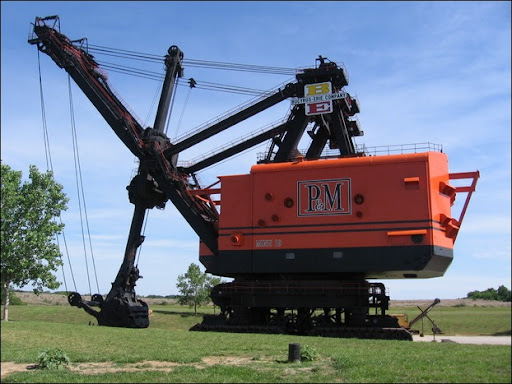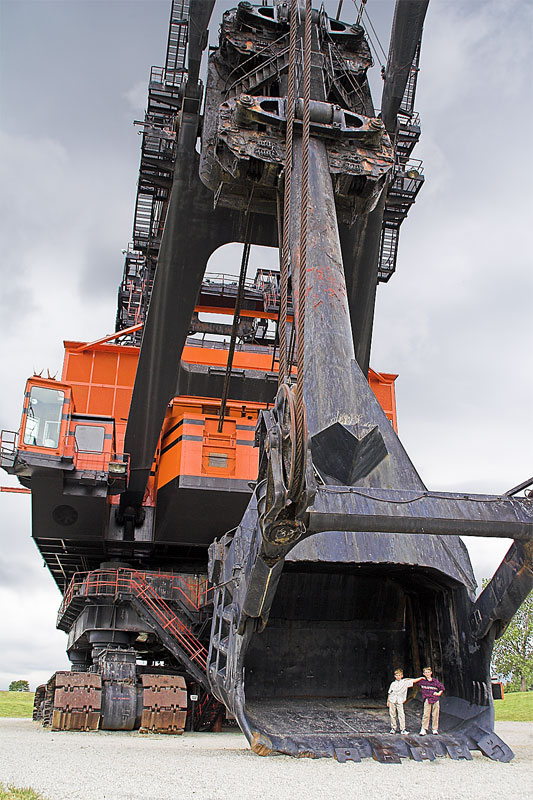Big Brutus
Big Brutus is the nickname of the Bucyrus - Erie 1850 -B, the construction time for his world's second largest shovel. He is unique, a local industrial monument half a kilometer south of West Mineral in the U.S. state of Kansas, and the largest yet to be considered cable excavator with front shovel.
Construction and operation
The Pittsburg and Midway Coal Mining Company (P & M), now a part of Chevron Corporation, 1962, he instructed the Bucyrus Erie Company electric shovel excavator 1850 -B to build. The contract value at the time was 6.5 million U.S. dollars. The items with up to 109 t ( 120 tn sh. ) Were produced in the Bucyrus - Erie factory in Milwaukee and transported with 150 rail cars after Hallowell. During the assembly from June 1962 were employed up to 52 workers for 11 months. The operations started mine 19 in May 1963 in the Pittsburg and Midway. At this time he was the world's second largest backhoe in operation. The name Big Brutus was the machine of Emil Sandeen, director of the Mine 19
The electric power shovel was being constructed in the open pit overburden with a thickness of six up to 21 m ( 20-69 ft) above a relatively thin seam of bituminous coal to remove. With a " bite" he moved 69 cubic meters (90 cu yd ) or about 122 tons ( 135 to sh. ). A duty cycle (filling - Pan - unloading - swinging back ) took 50 seconds. Every year, he could edit a floor area of about 2.6 km ² (1 mi ²). The supplied three-phase current was supplied from a separate transformer station of the Empire District Electric Company over a long cord. The electric wire rope excavator was a rotary converter and the engines were - as was customary - operated with direct current. The main drive consisted of two DC motors with an output power of 2,610 kW each (3,500 hp ). The energy efficiency was improved by the eight DC motors for the bucket with an output power of each of 373 kW (500 hp ), the braking energy fed back during the downward movement of the bucket. The operating crew consisted of three persons: the digger driver on the right front corner of the machine, the oiler who oversaw the automatic lubrication and the " Groundsman ". The latter made use of the four crawler tracks of a lower platform and also paid attention to an obstacle-free route. He received his instructions from the excavator driver by phone or horn signal. For automatic leveling an uneven surface, so that the superstructure was always horizontal, the chain drives via a respective hydraulic cylinder with a stroke of 168 cm (66 in ) connected to the substructure. There is a roller and cage of 13.7 m (45 ft) diameter, 90 whose cylindrical rollers have a diameter of 40.64 cm ( 16 in ) between the mobile base and the swivel superstructure. The spoon excavator high was essentially 24 hours a day, seven days a week in use and was driven in three layers. After removal of the overburden, the carbon ( 18 and 21 ) recovered from two seams with a thickness of 46 and 53 cm with a smaller device. This was then used in a local power plant to generate electricity. With the remote overburden after the pit was backfilled and rehabilitated the surface.
Service and museum
Although the electrical boom excavator was designed for a service life of 25 years, the operation was discontinued in April 1974 after 11 years. The operation had become unprofitable and environmental requirements sharper. Between 1963 and 1974 he had the overburden over an estimated 8 million tons ( 9 million tn sh. ) Coal removed. The cost of electricity in the last month of operation amounted to U.S. $ 27,000. The experiments, the excavator at other mines for sale, failed. In order to ship the excavator as a whole to another location, he was too big and a dismantling and rebuilding in a different location would have been too expensive. Electrical items have been sold to other mining companies.
In 1983, the Pittsburg and Midway Coal Mining Company donated the excavator and 6.5 hectares of land to the excavator in West Mineral Big Brutus the non-profit Incorporated, which receives the excavator for posterity. From volunteer thousands of hours have been spent to bring the hinrostenden ten years prior to dredging again in a respectable condition. In 2006, the next complete painting was done in orange and black. Previously could climb the boom, weather permitting individuals 13 years since 2004 but this is prohibited for safety reasons. Around Big Brutus smaller mining equipment are built. At the entrance of the machinery a small mining museum has been constructed in which there is to see more information and photos and a movie from an earlier period, as well as models of other mining machines. Approximately 35,000 to 40,000 people visit the museum annually, with the peak season between Memorial Day (May 30 ) and Labor Day ( first Monday in September ) is. The opening times are seasonal differently. During the year there are various events and festivals, such as on the first weekend in June, a meeting of former miners ( Miner 's Day Reunion ). In the vast plains of Kansas Big Brutus is already visible from afar. The last working pit is now a lake in the immediate vicinity of Big Brutus. In 1987 it was declared by the American Society of Mechanical Engineers (ASME ) as a local technical sight. Since the beginning of the ASME Mechanical Engineering Landmark program in 1971, it was next to 88 national and 23 international attractions, the tenth and local attractions, which was included in the program.
Until today the Bucyrus - Erie 1850 -B is the sixth - or seventh - largest excavators in the world. The largest ever backhoe Marion 6360, called " Captain," by Marion Power Shovel was scrapped in 1992. He had a bucket capacity of 140 m³. Greater still draglines with bucket wheel excavators and walking mechanism.










